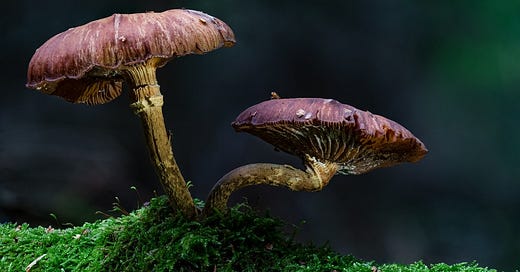Hey there Fungi Friday fans, happy Friday! We’re officially in that mid to late summer period where not a whole lot seems to be going on, so short publication this week. That being said, before we get into that, quick update on the fungi growing front. Checked in on the incubating spawn last weekend and to our dismay, more power struggles… so we finally did what we probably should have months ago. Put on our electrical engineering caps and finally ran the numbers, and guess what? Looks like it might simply be a case of not enough battery power… So, plan this week is to double the battery capacity and see where that takes us.
Even with the lack of power, spawn still looking decent, so we’ll move the 15 bags into fruiting after swapping out to our new batteries and the plan will be to pack 15 more next weekend. Also ended up ordering one more jar of blue oyster spawn this week, which should arrive early September. That’ll be the last go round for this growing season, which we’re guessing should last into late October, so at this point we’re essentially chalking this year up as a trial run. No worries though, we’re still as motivated as ever… we will grow high quality oysters, there’s still no doubt in my mind!
And with that, let’s get on to our two features of the week (I did say it’s a slow week ;)
Weird and wonderful world of fungi shaped by evolutionary bursts, study finds
Our first feature on this short story week comes from a writeup out of the University of Bristol, documenting how fungi, which much like the rest of nature, come in all sort of shapes and sizes. The article goes on to state the researchers findings, which show that fungal disparity has evolved through time, and that the evolution of multicellularity in different fungi appears to open the door for greater variety. They saw increases in disparity associated with both the emergence of the first fungi, and then the evolution of complex fruiting bodies such as mushrooms and saddles in the species.
Of the entire article, I think my favorite part comes from the quote “The world of fungi is defined by bright colors, strange shapes, and stranger anatomies. Our analyses demonstrate that this breath-taking anatomical variety has evolved in bursts, driven by evolutionary increases in multicellular complexity.” It’s the wide variety of colors, shapes, tastes and textures, along with the many, many different use cases that make the world of fungi fascinating!
The Bigger This Fungus Gets, the Worse We’re Doing
While I know we tend to focus on all of the great things related to fungi on this publication, there are also some scary, crazy and outright dreadful fungi out in the world, and one of them is the focus of issue number two today.
Deep in the loamy soil of forests around the world, there exists a fungus called the honey mushroom that makes its living on death. A parasite that preys on weak trees, it sucks its victims dry of nutrients, then feasts on their postmortem flesh. Orchards and vineyards have fallen to it; gardeners, farmers, and foresters spend their days fruitlessly fighting the pesticide-resistant scourge. Although the bulk of the fungus’s mass is underground, its devastation is visible to anyone who’s flown over the gray, balding patches of woodland where the pathogen has felled its hosts.
For those that have been around here a while, a few months back we covered another honey-fungus species, nicknamed Humongous Fungus, which has been around for thousands of years and is now one of the planet’s largest known organisms, and the biggest ever recorded by area on land. And even though these fungi tend to feast on the rest of the forest around them, that doesn’t make them villains. These decomposers that prune maladapted trees and returns their nutrients to the soil, so they play “quite a beneficial role in their ecosystems. After all, from life breeds death and from death breeds life, it’s all one continual cycle and these fascinating creatures just play their part in the much, much bigger picture.
Want even more? Here are some other interesting, mushroom focused reads of the week:
Slow week :( but we’ll do our best to bring you more fun Fungi articles next week, we promise!
As always, thank you for reading this weeks edition of Fungi Friday’s! If you enjoyed what you found, please feel free to forward to friends also interested in the Fungi Community!
And if you were forwarded this post and enjoyed what you found, please subscribe below:


